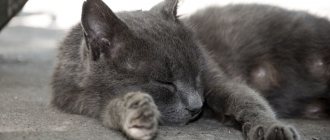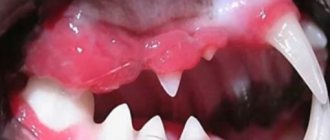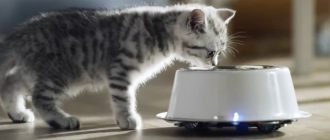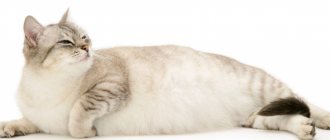Estrus (estrus) is a natural process for a cat’s body, indicating puberty of the pet. It is from the moment of the first estrus that a cat can become pregnant and bear kittens. But the owner who is not breeding the breed is more concerned about the external symptoms of estrus: changes in behavior, nutrition and, of course, loud screams at night.
In this article we will talk about the puberty of cats and all the pitfalls of this period that owners need to prepare for. And also how to alleviate the cat’s condition before the end of sexual heat.
Brief information about cat heat
| When does the first heat start? | Depending on the breed and weight of the kitten, estrus may begin between 6 and 12 months of age. |
| How long does a cat's heat last? | 5 – 14 days. |
| Periodicity | The beginning of the first heat of the year is the beginning of spring, the end is mid-autumn. Periods between heats:
After giving birth, your cat will go into heat within 3-5 months. |
| Common symptoms |
|
| When can you breed a cat? | A cat can only be bred for 2-3 heats, since during the first estrus the pet’s body is rarely ready to bear healthy offspring. |
| Does estrus go away after sterilization? | If a cat has had her ovaries removed (oophorectomy) or her ovaries and uterus (ovariohysterectomy), the cat will no longer be in heat. But if the uterus was removed while preserving the ovaries or the fallopian tubes were pulled, then all signs of sexual desire will remain. |
Signs of pathology during estrus
Sometimes only during this period can a still hidden pathology be noticed. Close attention should be paid to the following points:
- The duration of estrus should not exceed 20 days. Longer sexual heat may indicate hormonal disorders and pathologies of the reproductive organs;
- Discharge from the genital organs of the animal should not have a color: whitish or bloody. This sign indicates possible inflammatory diseases. Also, these secretions should not have an odor - any odor is a sign of pathology, usually of an inflammatory nature;
- The excretory system and gastrointestinal tract function in a normal, but somewhat extreme mode during the period of sexual heat. During the period of sexual heat, only frequent urination is typical; there should be no other deviations. If your cat is upset, constipated or has other signs of intestinal dysfunction, this is a serious sign that requires evaluation.
Mating games of cats
https://youtu.be/SQPQG0bMCp0
What is estrus
Estrus (the medical term is estrus) is the physiological and behavioral changes caused by hormonal changes by the age of 6-8 months. By this period, follicles have formed in the ovaries, and the female is ready for conception and gestation.
However, such an early pregnancy is usually difficult, the kittens are born weakened, and the cat takes a long time to recover after giving birth. Therefore, it is better to wait until 1.5 years of age before the first mating. By this time, the cat will get stronger and give birth to healthy offspring.
Some females may go into heat at 6 months, but puberty usually occurs between 8 and 10 months of age. You should worry about a cat’s absence of heat only after 18 months of life. In this case, the cat needs to be shown to a veterinarian, he will prescribe a vitamin complex, diet or complex treatment.
Reference! The first heat may occur without noticeable symptoms. Symptoms intensify by the 2nd year of life. Older cats go into heat without obvious symptoms.
Characteristic signs of estrus
A valuable purebred cat participating in breeding and exhibitions needs to select an equivalent breeding male for it. After the cat's first heat has occurred, the breeder proactively and prudently selects a candidate for mating. The future of kittens from a breeding pair whose value has been confirmed at competitions is predetermined. They will also participate in breeding and are intended to maintain the breed.
If the cat is approaching her age when her first heat begins, then the following signs are observed:
- The animal's genitals become swollen and there is light and clear discharge.
- The pet's appetite, daily routine and activity changes.
- The animal makes calling and drawn-out sounds, inviting a male to continue the race.
- The cat takes poses characteristic of mating, demonstrating with all appearance its readiness to mate with the male.
- The pet marks its territory. Urine containing pheromones attracts males to mate.
- The cat becomes affectionate and loving, attracting attention to itself in every possible way.
- Submitting to natural instinct, the animal tries to escape, even if your pet is a homebody from birth.
How long does the first heat take? It lasts a week, during which the characteristic symptoms first increase and then fade. The next time it will occur after 2-4 weeks, provided that pregnancy has not occurred.
At what age can it start?
The onset of the first heat depends on many factors:
| Factors influencing the timing of the first estrus | Factor influence |
| Cat breed | Long-haired breeds grow and mature somewhat later. These include large cat breeds:
Individuals of medium proportions mature much earlier:
|
| Birth season | Females born in summer mature faster than females born in the winter months. Therefore, you should not be surprised if the first heat begins at 5-7 months. |
| Heredity | Early puberty in parents is passed on to offspring. |
| Balanced diet and good care | A balanced diet rich in minerals, amino acids and vitamins, plus proper care for the animal, promotes proper development and normal puberty. |
| Illumination | If the animal lives in a very dark room, sexual activity occurs less frequently. |
| Presence of other cats in the house | When surrounded by other individuals, sexual activity occurs earlier. |
How many times a year does a cat walk?
The frequency of estrus depends on whether the cat has given birth or not. As a rule, cats after giving birth go for walks once every two months, and sometimes once a year. It is impossible to give a definite answer to the question of how long after giving birth the estrus will begin. As a rule, this happens after a month, but it all depends on the specific breed and the nature of the birth.
If the cat has not given birth, estrus occurs quite often - once every two weeks or month. If the owner wants to reduce the frequency of festivities, you can allow the animal to reproduce, or contact a veterinarian to prescribe hormonal medications.
Duration of estrus in different cat breeds
The duration of estrus directly depends on the breed of the pet.
British women are known for the rarest periods of festivities. The first heat occurs at the age of 7 months. Over time, the regularity of ovulation and its duration are disrupted;
Scottish women are famous for their early puberty - at 5 months. The duration of estrus is up to 6 days, the frequency is several times a year.
Symptoms
You can determine when your pet is in heat by the following symptoms:
- The animal's behavior changes . The cat becomes affectionate, rubs against pieces of furniture or the owner’s legs, and purrs. Or, on the contrary, the pet becomes very aggressive, and at any slightest contact with a person, it can scratch or bite.
- These days, your pet can roll on the floor, squirm or meow pitifully, and make strange uterine sounds, as if she is experiencing severe pain. But this, of course, is not true. This behavior in a cat can be observed not only during the day, but also at night.
- The female urinates more often , and she goes to the litter box more and more often.
- Appetite changes. The animal may partially or completely refuse to eat. Try to feed your cat small portions. And remember: clean, fresh water should always be present in the animal’s bowl.
- Your pet's genitals become slightly swollen. Transparent discharge appears from them . Therefore, the cat begins to lick its genitals frequently.
- The gait becomes strange and unnatural . The animal moves on half-bent legs.
- When stroking the back, the cat falls on its front paws, puts its tail to the side, and tramples with its hind paws.
- The pet can leave marks . This brings a lot of trouble to the owners. But you shouldn’t scold her for this, otherwise you will only make the situation worse.
Attention! If the animal is exhausted or, on the contrary, is obese, then the process of sexual activity can proceed completely unnoticed.
During this period, the cat may try to escape outside to the cats through a slightly open window or door, so watch your pet more closely.
Psychological and behavioral characteristics
Changes in hormonal levels affect the behavior of the animal, but since these signs are atypical, it is quite difficult to understand that a cat is in heat based on psychological changes. However, it is necessary to know how the behavior of an animal changes during sexual hunting - this will help to behave correctly during this period so as not to cause psychological trauma.
At this time, the female ceases to control herself - all her actions are determined by the changed hormonal background, which triggered the reproductive instinct. At the first stage, the cat is overly affectionate with people, even intrusive, and extremely excitable. But with cats, the female can be aggressive when trying to mate, but does not drive them away. The fact is that her body is not yet ready directly for mating.
At the second stage, behavior changes: aggression towards males decreases or disappears altogether, but the cat may even scratch or bite its owner - in no case should you scold it for this, the animal does not realize what it is doing.
If mating does not occur, the female experiences suffering - more psychological, due to the inability to get what her instincts require. At this time, her reactions may be completely inadequate.
If mating occurs, then human participation in this should be minimal: the slightest movement, loud sound, gesture can distract the animals from the process.
How long does heat last and how often?
A female who has previously given birth occurs in heat once every 2-3 months. And if the cat has not yet had offspring, then the heat will be once a month or even every 2 weeks.
This process lasts 5-14 days. It all depends on the individual characteristics of the animal’s body.
If the pet has already become pregnant and given birth, then estrus occurs no earlier than after 3-5 months.
The opinion that a cat must give birth at least once to be healthy is wrong.
How often do cats go into heat?
Cats are in heat seasonally. This means that the cat will go into heat again if she does not become pregnant. Seasonality is determined by a number of factors, including length of daylight, ambient temperatures and the presence of other cats. Under optimal conditions, the hormonal system is activated and the cat begins the estrus cycle. The mating season for cats in the northern hemisphere lasts from March to September, and in the southern hemisphere from October to March. Domestic cats may go into heat all year round until the cat becomes pregnant or is spayed.
Stages of estrus
The duration of the stages is individual for each cat. Signs may overlap each other. And therefore, it is sometimes difficult to determine the timing of mating with a cat.
Estrus is divided into four stages:
- Proestrus is the very first stage. It lasts from 1 to 5 days. At this time, the animal begins to require increased attention. Colorless discharge appears from the vagina. But, during this stage, the female is not yet ready for mating and fertilization, and therefore does not allow the male to approach her.
- Estrus is the second stage of estrus. It lasts 6-7 days. It all depends on the characteristics of your pet’s body. During the period of estrus, the animal meows loudly day and night, frightening its owners. When stroking, it raises the back of the body and moves the tail to the side. At this time, days 3-5 are considered the most favorable days for fertilization.
- Metestrus is the third stage of estrus, during which all signs of sexual activity begin to disappear. The cat is no longer interested in the cat. She only shows aggression towards him. This lasts for 7-8 days. It is possible that fertilization has occurred. At this time, embryos begin to develop. If this does not happen, then in 2-3 weeks the heat will appear again.
- Anestrus is the final stage of estrus. At this time, the pet becomes calm, all signs of sexual activity disappear.
Behavioral symptoms of estrus
Behavioral signs of estrus in cats:
- loud screams or rumbling;
- the cat actively fawns over its owners, rubs against legs and furniture (sometimes, on the contrary, it becomes aggressive);
- rolling on the floor.
It is the changes in behavior during estrus in cats that are noticeable by the owner. Often cats change very much, estrus is accompanied by constant loud screams, the behavior of a cat during estrus can greatly disturb the owners. Punishing a cat and requiring her to behave calmly during estrus is strictly not recommended - the hormones that provoke such behavior do not depend in any way on the desire of the cat or her upbringing. Hormonal products and drops, widely advertised on the market, can temporarily reduce the manifestations of unwanted behavior in cats, but they have a very serious impact on the cat’s health, and the risk of diseases of the reproductive system increases sharply, up to the occurrence of pyometra and the need for urgent surgery. If a cat's behavior during estrus worsens the owner's quality of life, it is recommended to sterilize her.
Estrus
— the second stage of estrus lasts 5-8 days. In terms of symptoms and physiology, it is practically no different from proestrus (follicles continue to grow and mature), but at the estrus stage the cat can be fertilized and stops repelling males.
Behavioral signs of readiness for fertilization:
- the cat arches its back, raises its butt, tramples with its hind paws, moves its tail to the side (especially if you touch the back in the sacrum area).
The optimal time for mating is 3-5 days of estrus.
Interestrus
— the third stage lasts 4-12 days (usually 7-9). A period of sexual inactivity, sexual arousal decreases, and if fertilization does not occur, the follicles regress.
Deviations from the norm
Prolonged heat
It happens that a pet is in heat for more than 2 weeks. This is called prolonged heat. This means an increase in the stages of estrus. There is a protracted proestrus, a protracted estrus and a protracted diestrus.
Symptoms of prolonged proestrus:
- The cat won't let the cat near.
- Discharge from the genitals continues for more than two weeks.
Symptoms of prolonged estrus:
- Estrus lasts more than 2-3 weeks, but fertilization does not occur.
Symptoms of prolonged diestrus:
- Mucous discharge from the female genitals does not stop for 21 days.
Anaphrodisia
Another deviation is the complete absence of estrus symptoms (anaphrodisia).
Symptoms:
- Lengthening of the intervals between estrus in a mature cat or its complete absence.
- Delayed puberty in a young individual.
If any of these deviations occur, be sure to show the cat to a specialist. He will prescribe competent treatment.
False pregnancy
It happens that fertilization does not occur. The female develops a so-called false pregnancy. This is a psychological condition during which the cat experiences all the signs of a non-existent pregnancy. The cause of the disease may lie in stressful situations, mating with an unproductive male, or a breed predisposition, for example, in sphinxes.
This condition lasts for 1-3 weeks. It is difficult to distinguish it from ordinary pregnancy.
Symptoms of false pregnancy:
- abdominal enlargement;
- swelling of the mammary glands;
- secretion of milk;
- increased appetite;
- constant thirst.
The pet's behavior also changes. She is looking for a secluded dark place, trying to arrange a bed for herself.
Also, your pet may begin to carry various soft toys in her teeth, mistaking them for her offspring.
This condition is dangerous because the cat can develop purulent mastitis.
Only a veterinarian can confirm whether it is a false pregnancy or a real one after examination. He will prescribe sedatives to stop lactation.
Empty heat
This is an estrus that did not result in the pet becoming pregnant. It can lead to many complications: ovarian cysts, inflammation and even cancer. Therefore, if you do not plan to mate your cat, it is best to have her spayed. You can read about all the nuances of this operation in our article on sterilization of cats.
Bloody issues
It is worth remembering that cats, unlike dogs, do not have bloody discharge. If you notice bloody discharge in a female, then this is a serious cause for concern and an urgent visit to the veterinary clinic.
Physiological changes
Physical manifestations of estrus are noticeable already at the first stage: an attentive owner will not miss them.
As a rule, you can determine when a cat is in heat already in the first days by the presence of discharge from the genitals: it is insignificant and transparent, without a distinct odor. This is what causes frequent licking. The genitals swell.
At the second stage, the female loses her appetite, and frequent urination may sometimes occur.
How to relieve a cat's condition
There are several options to alleviate the psychological and physical condition of the female during estrus:
- Give your furry pet more attention, pet her, hug her. All this will help relieve stress and calm her down a little.
- Distract with a new toy . Active games will help relieve your cat's nervous condition.
- Bathe the animal . Just do this in warm water and in a draft-free room. After bathing, the pet will begin to lick itself and clean itself up. This will give you several hours of long-awaited silence.
- Mating with a cat . If the cat is mature and healthy, and you are ready for offspring to appear in the house.
- Sedatives reduce sexual activity and help reduce stress.
- Hormonal drugs . You should not get carried away with these drugs, as they can cause great harm to your cat’s health.
- Sterilization . A suitable option for those owners who do not need kittens. This will not harm your pet and will help solve many problems that may arise.
Remember that the cat needs your love, affection and care during this difficult period. Therefore, you should not scold her for marks left on the floor, for constant “concerts”, for obnoxious behavior. You cannot lock your mustachioed pet in a cold, dark room. Try to be more patient, show more affection and attention to your ward.
Stages
Sexual arousal in a cat occurs in several stages:
- proestrus;
- estrus;
- metestrus;
- anestrus.
© shutterstock
Let's take a closer look at these phases and their signs.
The first stage is called proestrus . This is a period that lasts from one to four days. During this period, the animal behaves more or less calmly. You will notice that your pet has become more affectionate and all the time, as if begging to be petted. The cat eats well, maybe even more than usual. Another sign that will indicate the onset of estrus is soft, extended sounds. The animal’s genitals “swell” and increase in size. The first transparent discharge appears.
But at this stage you should not take the cat to the cat, since she will not let him near her yet. For mating, expect the following signs of your female cat's heat.
The second phase is called estrus . It lasts for different times in different breeds of animals. But often estrus goes away in one to one and a half weeks. The signs of estrus in a cat during the estrus phase are the most striking, because this stage, in fact, is the estrus itself.
So, what happens to the cat when the estrus phase begins, what are its signs? The cat's behavior changes dramatically. She literally “gets kinder before our eyes,” that is, she begins to wriggle, meow very loudly, and roll around on the floor. By stroking the animal on the bottom of its back, you will see that it will stand in a position characteristic of mating , with its tail turned to its side. There is no need to worry about your pet, she is fine. This behavior is inherent in nature itself and is absolutely natural.
If you notice signs of estrus and want to have kittens, then use this period for mating. The most optimal period for mating is approximately the third to fifth day of estrus. Therefore, if you notice its signs, look for a cat to breed.
After pronounced estrus, the third stage begins - metestrus. At this time, the cat's sex drive decreases. This phase lasts from three to twelve days. If during the previous stage she became pregnant, now she will no longer let the cat near her.











